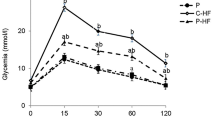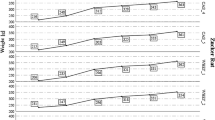Abstract
Lifestyle and diet preferences are primarily responsible for developing type 2 diabetes. In this study, okara was manufactured into okara whey crackers (OWC) to investigate its dietary role in controlling diabetes in streptozotocin-diabetic rats with and without a high-fat diet. Forty-eight rats were divided into eight groups. G1–G4 were nondiabetic and fed a basal diet, a basal diet with 30% crackers, high fat diet, and a high-fat diet with 30% crackers, respectively. G5–G8 were diabetic groups that received similar diets as previous groups. Blood glucose, liver function, lipid pattern, pancreas and liver histopathology, and insulin immunohistochemistry were performed. OWC improved measured parameters and histopathology of the liver and pancreas in diabetic rats. The area % of positive insulin cells was increased in G6 (5.20%) and G8 rats (2.83%) fed OWC compared to diabetic rats (1.17%). In conclusion, the use of 30% OWC in a semi-modified diet has controlled the hyperglycemia and hyperlipidemia associated with diabetes.



Similar content being viewed by others
References
Ahmed LA, Hassan DR, Hemeda HM. Anti-hyperglycemic effects of okara, corn hull, and their combination in alloxan-induced diabetic rats. World Appl. Sci. J. 9: 1139-1147 (2010)
A.O.A.C. Official Methods of Analysis of AOAC. Intl. 18th ed. Association of Official Analytical Chemists, Rockville, Maryland, USA (2005)
Bai F, Jiang F, Lu J, Ma S, Peng, Y, Jin Y, Xu W, Cheng J, Wu H. The Impact of hyperglycemic emergencies on the kidney and liver. J. Diabetes Res. 2013: 967097 (2013)
Bland JS. Jeffrey S. Bland, PhD, FACN, CNS: functional medicine pioneer. Altern. Ther. Health Med. 10: 74-81 (2004)
Bolzán AD, Bianchi MS. Genotoxicity of streptozotocin. Mutat. Res.-Rev. Mutat. Res. 512: 121-134 (2002)
Bose D, Shams-Ud-Din M. The effect of chickpea (Cicer arietinim) husk on the properties of cracker biscuits. J. Bangladesh Agril. Univ. 8: 147-152 (1970)
Cantero I, Abete I, Monreal J, Martinez J, Zulet M. Fruit fiber consumption specifically improves liver health status in obese subjects under energy restriction. Nutrients 9: 667 (2017)
Chen C, Zeng Y, Xu J, Zheng H, Liu J, Fan R, Zhu W, Yuan L, Qin Y, Chen S, Zhou Y, Wu Y, Wan J, Mi M, Wang, J. Therapeutic effects of soluble dietary fiber consumption on type 2 diabetes mellitus. Exp. Ther. Med. 12: 1232-1242 (2016)
Coskun O, Kanter M, Korkmaz A, Oter S. Quercetin, a flavonoid antioxidant, prevents and protects streptozotocin-induced oxidative stress and β-cell damage in rat pancreas. Pharmacol. Res. 51: 117-123 (2005)
De Feo P, Gaisano MG, Haymond MW. Differential effects of insulin deficiency on albumin and fibrinogen synthesis in humans. J. Clin. Invest. 88: 833-840 (1991)
Dreon DM, Fernstrom HA, Campos H, Blanche P, Williams PT, Krauss RM. Change in dietary saturated fat intake is correlated with change in mass of large low-density-lipoprotein particles in men. Am. J. Clin. Nutr. 67: 828-836 (1998)
Elreffaei W. Biological evaluation of okara in rats based on plasma lipid profile and histology. Int. J. Plant Soil Sci. 3: 507-522 (2014)
Ercisli S, Akbulut M, Ozdemir O, Sengul M, Orhan E. Phenolic and antioxidant diversity among persimmon (Diospyrus kaki L.) genotypes in Turkey. Int. J. Food Sci. Nutr. 59: 477-482 (2008)
Farbstein D, Levy AP. HDL dysfunction in diabetes: causes and possible treatments. Expert Rev. Cardiovasc. Ther. 10: 353-361 (2012)
Giacco F, Brownlee M. Oxidative stress and diabetic complications. Circ. Res. 107: 1058-1070 (2010)
Grizotto RK, Rufi CR, Yamada EA, Vicente E. Evaluation of the quality of a molded sweet biscuit enriched with okara flour. Ciênc. Technol. Aliment 30: 270-275 (2010)
Guo X, Yang B, Tang J, Li D. Fatty acid, and non-alcoholic fatty liver disease: meta-analyses of case-control and randomized controlled trials. Clin. Nutr. 37: 113-122. (2018)
Hosokawa M, Katsukawa M, Tanaka H, Fukuda H, Okuno S, Tsuda K, Iritani N. Okara ameliorates glucose tolerance in GK rats. J. Clin. Biochem. Nutr. 58: 216-222 (2016)
Ickin GM, Guven BA, Yavuz O, Hismiogullari AA. Histopathological changes in rat pancreas and skeletal muscle associated with high fat diet induced insulin resistance. Biotech. Histochem. 90: 495–505 (2015)
Jiang F, Morahan G. Pancreatic stem cells remain unresolved. Stem Cells Dev. 23: 2803-2812 (2014)
Khan A, Bryden NA, Polansky MM, Anderson RA. Insulin potentiating factor and chromium content of selected foods and spices. Biol. Trace Elem. Res. 24: 183-188 (1990)
Li B, Qiao M, Lu F. Composition, nutrition, and utilization of okara (soybean residue). Food Rev. Int. 28: 231-252 (2012)
Lu F, Liu Y, Li B. Okara dietary fiber and hypoglycemic effect of okara foods. Bioact. Carbohydr. Diet. Fibre. 2: 126-132 (2013)
Lopes-Virella MF, Stone P, Ellis S, Colwell JA. Cholesterol determination in high-density lipoproteins separated by three different methods. Clin. Chem. 23: 882-884 (1977)
O’Toole DK. Characteristics and use of okara, the soybean residue from soy milk production a review. J. Agric. Food Chem. 47: 363-371 (1999)
Parry SA, Hodson L. Influence of dietary macronutrients on liver fat accumulation and metabolism. J. Invest. Med. 65:1102-1115 (2017).
Préstamo G, Rupérez P, Espinosa-Martos I, Villanueva MJ, Lasunción MA. The effects of okara on rat growth, cecal fermentation, and serum lipids. Eur. Food Res. Technol. 225: 925-928 (2006)
Requena M, Aguilar-González C, Barragn L, Cunha M, Correia M, Esquivel J, Herrera R. Dietary fiber: an ingredient against obesity. Emir. J. Food. Agric. 28: 522-530 (2016)
Rodríguez R, Jiménez A, Fernández-Bolaños J, Guillén R, Heredia A. Dietary fibre from vegetable products as source of functional ingredients. Trends Food Sci. Technol. 17: 3-15 (2006)
Scalia R, Gong Y, Berzins B, Zhao LJ, Sharma K. Hyperglycemia is a major determinant of albumin permeability in diabetic microcirculation: the role of mu- calpain. Diabetes 56: 1842-1849 (2007)
Senica M, Stampar F, Mikulic-Petkovsek M. Different extraction processes affect the metabolites in blue honeysuckle (Lonicera caerulea L. subsp. edulis) food products. Turk. J. Agric. For. 43: 576-585 (2019)
Shanmugasundaram E, Gopinath K, Shanmugasundaram K, Rajendran V. Possible regeneration of the islets of Langerhans in streptozotocin-diabetic rats given Gymnema sylvestre leaf extracts. J. Ethnopharmacol. 30: 265-279 (1990)
Sukkar SG, Bounous G. The role of whey protein in antioxidant defense. Riv. Ital. Nutr. Parenter. Enter. 22: 193-200 (2004)
Theuwissen E, Mensink RP. Water-soluble dietary fibers and cardiovascular disease. Physiol. Behav. 94: 285-292 (2008)
Thoma C, Day CP, Trenell MI. Lifestyle interventions for the treatment of non-alcoholic fatty liver disease in adults: a systematic review. J. Hepatol. 56: 255-266 (2012)
Wallach JB. Interpretation of Diagnostic Tests. 8th Ed. Lippincott Williams & Wilkins, Philadelphia, PA, USA (2007)
Wu Y, Ding Y, Tanaka Y, Zhang W. Risk factors contributing to type 2 diabetes and recent advances in the treatment and prevention. Int. J. Med. Sci. 11: 1185-1200 (2014)
Yazdanparast R, Esmaeili MA, Helan JA. Teucrium polium extract effects pancreatic function of streptozotocin diabetic rats: a histopathological examination. Iran. Biomed. J. 9: 81-85 (2005)
Zia-Ul-Haq M, Ahmad S, Bukhari SA, Amarowicz R, Ercisli S, Jaafar HZE. Compositional studies and biological activities of some mash bean (Vigna mungo (L.) Hepper) cultivars commonly consumed in Pakistan. Biol. Res. 47:23 (2014)
Acknowledgments
We would like to thank the technicians in the Biochemistry Department, Faculty of Agriculture, Giza, Egypt for taking good care of animals and for assisting in sample collection.
Author information
Authors and Affiliations
Corresponding author
Ethics declarations
Conflict of interest
The authors declare that they have no conflict of interest.
Additional information
Publisher's Note
Springer Nature remains neutral with regard to jurisdictional claims in published maps and institutional affiliations.
Rights and permissions
About this article
Cite this article
Abdel-Mobdy, A.E., Khattab, M.S., Mahmoud, E.A. et al. Semi-modified okara whey diet increased insulin secretion in diabetic rats fed a basal or high fat diet. Food Sci Biotechnol 30, 107–116 (2021). https://doi.org/10.1007/s10068-020-00842-3
Received:
Revised:
Accepted:
Published:
Issue Date:
DOI: https://doi.org/10.1007/s10068-020-00842-3




